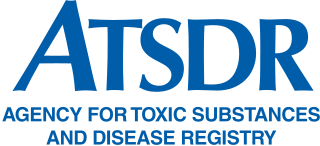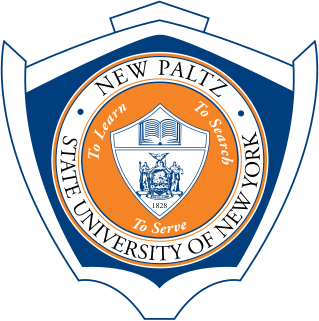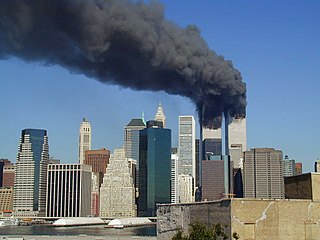Related Research Articles
In toxicology, the median lethal dose, LD50 (abbreviation for "lethal dose, 50%"), LC50 (lethal concentration, 50%) or LCt50 is a toxic unit that measures the lethal dose of a toxin, radiation, or pathogen. The value of LD50 for a substance is the dose required to kill half the members of a tested population after a specified test duration. LD50 figures are frequently used as a general indicator of a substance's acute toxicity. A lower LD50 is indicative of increased toxicity.

Polychlorinated biphenyls (PCBs) are highly carcinogenic chemical compounds, formerly used in industrial and consumer products, whose production was banned in the United States by the Toxic Substances Control Act in 1979 and internationally by the Stockholm Convention on Persistent Organic Pollutants in 2001. They are organic chlorine compounds with the formula C12H10−xClx; they were once widely used in the manufacture of carbonless copy paper, as heat transfer fluids, and as dielectric and coolant fluids for electrical equipment.
Polychlorinated dibenzodioxins (PCDDs), or simply dioxins, are a group of long-lived polyhalogenated organic compounds that are primarily anthropogenic, and contribute toxic, persistent organic pollution in the environment.

Sarin is an extremely toxic synthetic organophosphorus compound. A colourless, odourless liquid, it is used as a chemical weapon due to its extreme potency as a nerve agent. Exposure is lethal even at very low concentrations, where death can occur within one to ten minutes after direct inhalation of a lethal dose, due to suffocation from respiratory paralysis, unless antidotes are quickly administered. People who absorb a non-lethal dose and do not receive immediate medical treatment may suffer permanent neurological damage.

Brittany Anne Murphy-Monjack was an American actress and singer. Born in Atlanta, Murphy moved to Los Angeles as a teenager and pursued a career in acting. Her breakthrough role was as Tai Frasier in Clueless (1995), followed by supporting roles in independent films such as Freeway (1996) and Bongwater (1998). She made her stage debut in a Broadway production of Arthur Miller's A View from the Bridge in 1997 before appearing as Daisy Randone in Girl, Interrupted (1999) and as Lisa Swenson in Drop Dead Gorgeous (1999).

The September 11 attacks transformed the first term of President George W. Bush and led to what he has called the war on terror. The accuracy of describing it as a "war" and its political motivations and consequences are the topic of strenuous debate. The U.S. government increased military operations, economic measures, and political pressure on groups that it accused of being terrorists, as well as increasing pressure on the governments and countries which were accused of sheltering them. October 2001 saw the first military action initiated by the US. Under this policy, NATO invaded Afghanistan to remove the Taliban regime and capture al-Qaeda forces.

The Agency for Toxic Substances and Disease Registry (ATSDR) is a federal public health agency within the United States Department of Health and Human Services. The agency focuses on minimizing human health risks associated with exposure to hazardous substances. It works closely with other federal, state, and local agencies; tribal governments; local communities; and healthcare providers. Its mission is to "Serve the public through responsive public health actions to promote healthy and safe environments and prevent harmful exposures." ATSDR was created as an advisory, nonregulatory agency by the Superfund legislation and was formally organized in 1985.

Love Canal is a neighborhood in Niagara Falls, New York, United States, infamous as the location of a 0.28 km2 (0.11 sq mi) landfill that became the site of an enormous environmental disaster in the 1970s. Decades of dumping toxic chemicals harmed the health of hundreds of residents; the area was cleaned up over the course of 21 years in a Superfund operation.

The State University of New York at New Paltz is a public university in New Paltz, New York. It traces its origins to the New Paltz Classical School, a secondary institution founded in 1828 and reorganized as an academy in 1833.

Lindane, also known as gamma-hexachlorocyclohexane (γ-HCH), gammaxene, Gammallin and benzene hexachloride (BHC), is an organochlorine chemical and an isomer of hexachlorocyclohexane that has been used both as an agricultural insecticide and as a pharmaceutical treatment for lice and scabies.

The September 11 attacks, commonly known as 9/11, were four coordinated suicide terrorist attacks carried out by the militant Islamic extremist network al-Qaeda against the United States on Tuesday, September 11, 2001. That morning, nineteen terrorists hijacked four commercial airliners scheduled to travel from the northeastern U.S. to California. The hijackers crashed the first two planes into the Twin Towers of the World Trade Center in New York City, and the third plane into the Pentagon in Arlington, Virginia. The fourth plane was intended to hit a federal government building in Washington, D.C., but crashed in a field following a passenger revolt. The attacks killed nearly 3,000 people and instigated the global war on terror.

The health effects arising from the September 11 attacks refers to the illnesses and negative health effects experienced by survivors of the terrorist attacks. Within seconds of the collapse of the World Trade Center, building materials, electronic equipment, and furniture were pulverized and spread over the area of the Financial District of Lower Manhattan.
Toxic Legacy is a Canadian documentary film that was produced by Susan Teskey for the Canadian Broadcasting Corporation. It was broadcast on the CBC and Discovery Times on September 5, 2006. The film deals with the toxic legacy of the Ground Zero dust following the September 11, 2001 attacks upon the World Trade Center.

As Mayor of New York City on September 11, 2001, Rudy Giuliani played a major role in the response to the terrorist attacks against the World Trade Center towers in the city.
Materials MASINT is one of the six major disciplines generally accepted to make up the field of Measurement and Signature Intelligence (MASINT), with due regard that the MASINT subdisciplines may overlap, and MASINT, in turn, is complementary to more traditional intelligence collection and analysis disciplines such as SIGINT and IMINT. MASINT encompasses intelligence gathering activities that bring together disparate elements that do not fit within the definitions of Signals Intelligence (SIGINT), Imagery Intelligence (IMINT), or Human Intelligence (HUMINT).

James Zadroga was a New York City Police Department (NYPD) officer who died of a respiratory disease that has been attributed to his participation in rescue and recovery operations in the rubble of the World Trade Center following the September 11 attacks. Zadroga was the first NYPD officer whose death was attributed to exposure to his contact with toxic chemicals at the attack site.
Jane L. Delgado is a Cuban-American clinical psychologist, health care advocate, non-profit executive, and author. She is president and CEO of the National Alliance for Hispanic Health. She is the author of The Buena Salud Guide book series and The Latina Guide to Health. In 2012 the series was acquired by William Morrow an Imprint of HarperCollins Publishers and published "Buena Salud Guide to Arthritis and Your Life."

The Station is an Italian restaurant and former train station in the village of New Paltz in Ulster County, New York. The building was the first of two railroad stations constructed in the town of New Paltz, and it is the only former Wallkill Valley Railroad station standing at its original location.
A health crisis or public health crisis is a difficult situation or complex health system that affects humans in one or more geographic areas, from a particular locality to encompass the entire planet. Health crises generally have significant impacts on community health, loss of life, and on the economy. They may result from disease, industrial processes or poor policy.

The World Trade Center Health Program provides medical benefits to specific groups of individuals affected by the September 11, 2001, terrorist attacks on the United States. The WTC Health Program was established by Title I of the James Zadroga 9/11 Health and Compensation Act, P.L. 111-347, which amended the Public Health Service Act. The United States Congress passed the bill in December 2010 and United States President Barack Obama signed it into law on January 2, 2011. The Zadroga Act required the WTC Health Program to begin administering medical benefits on July 1, 2011. On December 18, 2015, the Zadroga Act was reauthorized to provide medical benefits to affected individuals until 2090. The National Institute for Occupational Safety and Health (NIOSH), within the Centers for Disease Control and Prevention, administers the program. The Centers for Disease Control and Prevention is component of the United States Department of Health and Human Services (HHS).
References
- ↑ http://www.bowdoin.edu/hermod/event?bid=242461&rid=28835%5B%5D
- ↑ "State University of New York at New Paltz: News - General News". Archived from the original on 2007-09-27. Retrieved 2006-11-19.
- ↑ "Conseil régional de l'environnement de Montréal". Archived from the original on 2007-09-28. Retrieved 2006-11-19.